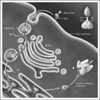Shiga toxin-associated hemolytic uremic syndrome: advances in pathogenesis and therapeutics
- PMID: 22660553
- PMCID: PMC5303627
- DOI: 10.1097/MNH.0b013e328354a62e
Shiga toxin-associated hemolytic uremic syndrome: advances in pathogenesis and therapeutics
Abstract
Purpose of review: Diarrhea-associated hemolytic uremic syndrome (HUS) caused by Shiga toxin-producing Escherichia coli (STEC) continues to be an important public health threat worldwide. Specific therapies are lacking and patient care remains largely supportive. This review discusses the lessons learned from recent events and summarizes key advances made toward understanding the basic mechanisms involved in the pathogenesis of typical HUS.
Recent findings: The recent German outbreak of a hybrid organism resulted in an unprecedented number of HUS cases and drastically changed the face of typical (diarrhea-associated) HUS. New findings on the roles of complement and the CXCR4/SDF-1 pathway in HUS pathogenesis are summarized and novel therapeutic strategies are highlighted.
Summary: A better understanding of STEC-mediated HUS underlies improved therapeutic approaches. New studies of the mechanistic basis of the disease, together with patient-based studies, have led to key findings with important clinical implications.
Conflict of interest statement
There are no conflicts of interest.
Figures



References
-
- Johnson S, Waters A. Is complement a culprit in infection-induced forms of haemolytic uraemic syndrome? Immunobiology. 2012;217:235–243. - PubMed
-
- Noris M, Remuzzi G. Atypical hemolytic-uremic syndrome. N Engl J Med. 2009;361:1676–1687. - PubMed
-
- Karmali MA, Gannon V, Sargeant JM. Verocytotoxin-producing Escherichia coli (VTEC) Vet Microbiol. 2010;140:360–370. - PubMed
-
- Tarr PI, Gordon CA, Chandler WL. Shiga-toxin-producing Escherichia coli and haemolytic uraemic syndrome. Lancet. 2005;365:1073–1086. - PubMed
Publication types
MeSH terms
Substances
Grants and funding
LinkOut - more resources
Full Text Sources
Medical
Research Materials

